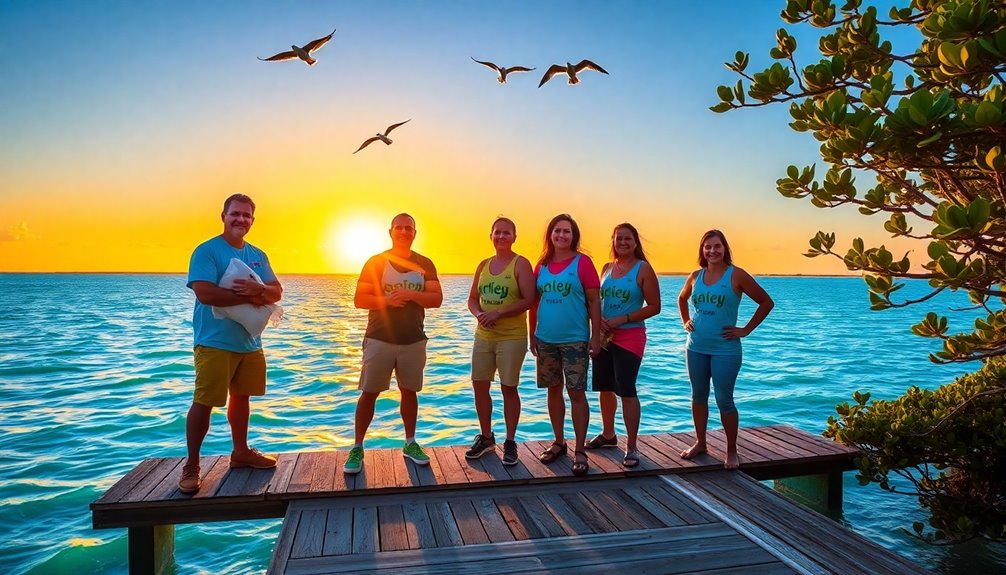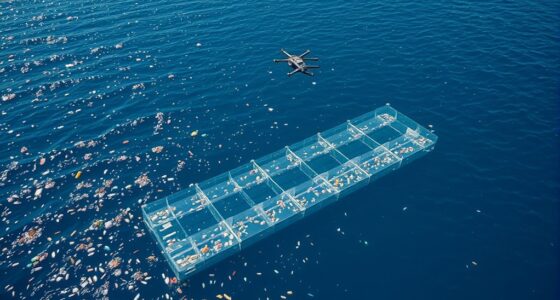Pioneering coastal guardians are working tirelessly to shield the Florida Keys' coastline from climate change and environmental threats. They focus on nature-based solutions like mangrove restoration and hybrid approaches to stabilize shorelines. With technology, they analyze effective strategies and empower community involvement. These efforts protect not just the environment but also local properties. Want to discover more about how these guardians are making a difference? Keep exploring the transformative initiatives underway in the Keys.
Key Takeaways
- Coastal guardians implement nature-based solutions like mangrove and coastal strand restoration to protect the Florida Keys from erosion and flooding risks.
- They utilize hybrid approaches that combine natural elements with engineered structures for effective shoreline stabilization.
- Technological tools, such as GIS-based systems and machine learning, guide the evaluation and selection of the best coastal protection strategies.
- Collaboration with organizations like Florida Atlantic University and NOAA enhances project implementation and fosters community involvement in conservation efforts.
- Engaging local communities strengthens support for initiatives aimed at preserving the region's biodiversity and resilience against climate threats.

As the Florida Keys face escalating threats from climate change, coastal guardians are stepping up to protect these fragile ecosystems. These initiatives and individuals are dedicated to safeguarding coastal regions from environmental hazards, employing nature-based solutions to mitigate climate risks like sea level rise, hurricanes, and flooding. You'll find that their efforts help stabilize shorelines, enhancing ecosystem resilience while protecting properties along the coast.
With sea levels expected to rise by up to 0.30 meters by 2050 and the increasing frequency of hurricanes—like Irma and Ian—the vulnerabilities of the Keys are becoming painfully clear. The low-lying geography makes flooding a constant risk, and the existing infrastructure complicates effective flood management. It's crucial to recognize that coral reefs and mangroves, key components of marine ecosystems, are under significant threat from these changes. The Iconic Reef Guardians Program offers opportunities for divers and snorkelers to engage in coral reef restoration, further supporting the health of these vital ecosystems.
Rising sea levels and increasing hurricanes expose the Florida Keys' vulnerabilities, threatening vital coral reefs and mangroves.
Coastal guardians focus on nature-based solutions, such as mangrove restoration and coastal strand restoration, which create resilient barriers against erosion. By combining natural elements with engineered structures—known as hybrid approaches—they tailor protection to the unique conditions of each area.
Soft armoring, which utilizes materials like plants and sand dunes, offers a sustainable way to shield shorelines from the forces of nature.
Technological tools play a vital role in these efforts. GIS-based tools and multi-criteria decision models help analyze and assess the best shoreline reinforcement methods. Machine learning assists in identifying the most effective stabilization strategies, ensuring that you have the best data to guide these initiatives.
Collaboration is key; partnerships with organizations like Florida Atlantic University and NOAA empower coastal guardians to implement successful projects.
Community involvement strengthens these initiatives, fostering grassroots support essential for long-term success. By engaging multiple stakeholders, coastal guardians create a united front against the complex challenges facing the Florida Keys. Together, they work tirelessly to preserve the biodiversity and marine ecosystems that define this beautiful region.
Frequently Asked Questions
What Specific Challenges Do Coastal Guardians Face in Their Work?
You'll find coastal guardians face numerous challenges in their work.
Rising sea levels and increased flooding threaten both ecosystems and infrastructure. They need to design nature-based solutions carefully while ensuring stakeholder buy-in.
With limited suitable areas and the need for advanced technologies, coordinating efforts becomes essential.
Additionally, balancing conservation goals with community interests can complicate their mission.
Effective communication and collaboration among various entities are crucial for successful shoreline protection initiatives.
How Can Locals Get Involved With Coastal Guardians?
You can get involved with coastal guardians by participating in community outreach programs, attending local workshops, or volunteering for clean-up events.
Join citizen science initiatives to contribute to research while fostering a sense of ownership.
Support local non-profits focused on conservation and stay informed about policy changes.
Engaging with your neighbors and promoting sustainable practices can also amplify your impact, ensuring that everyone plays a role in protecting your coastal environment.
What Types of Training Do Coastal Guardians Undergo?
Coastal Guardians undergo diverse training to equip you with essential skills.
You'll learn about coastal stabilization methods, erosion prevention strategies, and storm management techniques. Education focuses on marine ecosystems and the impact of climate change, fostering sustainable practices.
You'll also develop geospatial analysis skills, using technology to assess vulnerabilities. Collaborative efforts emphasize partnerships with local communities and stakeholders, ensuring you're well-prepared to contribute to coastal resilience and protection efforts effectively.
Are There Volunteer Opportunities for Students in the Program?
Yes, there are volunteer opportunities for students in various conservation programs.
If you're 16 or older, you can engage in roles that focus on coral restoration, wildlife conservation, and habitat projects.
These experiences not only allow you to contribute to environmental stewardship but also help you develop valuable skills like GIS and buoy installation.
Plus, volunteering can lead to certificates and awards, enhancing your educational journey and fostering connections with like-minded individuals.
How Is Funding Secured for Coastal Guardians' Initiatives?
Funding for coastal guardians' initiatives is secured through various strategies.
You can tap into government programs like the Resilient Florida Trust Fund and seek partnerships with organizations such as The Nature Conservancy.
Legislative actions often allocate funds for specific projects, while private grants and public funding play crucial roles.
Engaging local communities and prioritizing resource management also enhances opportunities for sustainable funding, ensuring effective coastal conservation efforts continue.
Conclusion
So, next time you think about lounging on the beach, remember our Coastal Guardians aren't just fighting for your Instagram backdrop. They're battling rising seas, invasive species, and the occasional clueless tourist who thinks "leave no trace" means "leave the trash on the sand." While you sip your piña colada, these unsung heroes are out there, ensuring your paradise doesn't turn into a plastic-laden wasteland. Cheers to them—may their sunscreen be as strong as their resolve!









